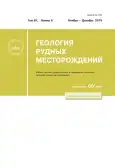Том 61, № 6 (2019)
- Год: 2019
- Выпуск опубликован: 17.12.2019
- Статей: 5
- URL: https://journals.eco-vector.com/0016-7770/issue/view/1121
- DOI: https://doi.org/10.31857/S0016-7770616
Статьи
Месторождения золота в истории Земли
Аннотация
Рассмотрено распределение основных месторождений золота в истории Земли. Показана первичная неоднородность архейской коры по золотоносности. Охарактеризованы основные золоторудные металлогенические эпохи. Показаны преобладающие связи золотых орогенных месторождений с колчеданными и медно-никелевыми в ранние периоды Земли (архей–протерозой), и с месторождениями вольфрама, молибдена, меди, сурьмы, ртути и олова в фанерозое. Анализ распространения минералого-геохимических типов собственно золотой минерализации также показал существенное разнообразие их для фанерозоя по сравнению с докембрием. Эти данные отражают мантийно-коровое происхождение золотой минерализации в целом и свидетельствуют об увеличении вклада вещества коры в баланс золотой минерализации с возрастом Земли. Обсужден известный перерыв в формировании месторождений золота (1.7–0.8 млрд лет), который обусловлен стабильным кратонным режимом длительно существовавшего суперконтинента Колумбия (Нуна) – Родиния.
 3-18
3-18


Глобальная металлогения тантала в геологическом времени
Аннотация
Проанализировано глобальное распределение месторождений танталоносных руд и заключенных в них ресурсов тантала на шкале геологического времени. Основой для анализа стали данные по 65 месторождениям мира с ресурсной оценкой от 2 тыс. т Ta2O5, которые были классифицированы на пять типов: пегматитовый, гранитный, щелочногранитный, фоидный и карбонатитовый. Россыпи и рудоносные коры выветривания были учтены совместно с их коренными источниками. Вариативные особенности глобальной металлогении тантала представлены на основе сопоставления суперконтинентальных циклов. Установлено, что наиболее значительные в количественном аспекте ресурсы заключены в месторождениях родинийского цикла, среди которых абсолютно доминируют объекты фоидного типа. Далее, в порядке убывания суммарных ресурсов, следуют пангейский и колумбийский циклы, в которых главные доли в ресурсах имеют месторождения щелочногранитного и фоидного типов. Уступающий им в количественной оценке кенорский цикл выделяется в металлогении тантала монотипностью: только пегматитовые объекты создали его ресурсный потенциал. Текущий амазийский цикл стоит на последнем месте по общему количеству ресурсов тантала, что во многом объяснимо его незавершенностью. Ресурсы этого цикла распределены между объектами щелочногранитного, гранитного и пегматитового типов в сопоставимых долях. Отмечено, что из-за своих минералогических особенностей месторождения пегматитового и гранитного типов позволяют получать наиболее высококачественные концентраты и поэтому представляют первоочередной интерес для извлечения тантала. Месторождения пегматитового типа известны во всех циклах, а гранитного – только в пангейском и амазийском. Суммарно они заключают в себе только пятую часть оцененных ресурсов тантала, причем основная их доля приходится на кенорский и пангейский циклы.
 19-37
19-37


Взаимосвязанные реакции растворения-переотложения минералов теннантит-тетраэдритовой серии на золоторудном месторождении Дарасун (Восточное Забайкалье, Россия)
Аннотация
В золоторудном месторождении Дарасун обнаружены неоднородные ритмично-зональные агрегаты теннантита-IV, заместившие частично или полностью ранние однородные зерна Zn-тетраэдрита-I и идиоморфные кристаллы (Fe-Zn)-теннантита-I. Наблюдаются различные стадии замещения блеклой руды: оно начинается по границам зерен и заканчивается полным превращением в псевдоморфные агрегаты (Zn-Fe)-теннантита-IV, окаймленные Zn-тетраэдритом-IV. Последние тесно ассоциируют с бурнонитом и галенитом, отложение которых инициировало образование псевдоморфоз. Результаты РСМА показали, что на начальных стадиях отлагается (Fe-Zn)-тетраэдрит с более высоким содержанием As, чем в Zn-тетраэдрите-I. В зонально-неоднородном агрегате преобладает теннантит с широкими вариациями соотношений Sb/(Sb + As) и Fe/(Fe + Zn). В (Fe-Zn)-тетраэдрит-теннантите-IV проявлена отрицательная зависимость между соотношениями Sb/(Sb + As) и Fe/(Fe + Zn). В каждом участке на границе Zn-тетраэдрита-I и новообразованного теннантита-IV происходит разрыв смесимости между As и Sb и резкое падение Sb/(Sb + As) и увеличение Fe/(Fe + Zn). Резкие, зубчатые границы между Zn-тетраэдритом-I и новообразованным теннантитом-IV и наличие пор в новообразованном агрегате свидетельствуют о том, что образование псевдоморфоз произошло в результате взаимосвязанных реакций растворения-переотложения. Растворение инициировано нарушением химического равновесия между Zn-тетраэдритом-I и ненасыщенным флюидом из-за кристаллизации ассоциации галенита и бурнонита. Отложение тетраэдрит-теннантита-IV происходило при колебательных изменениях соотношений Sb/(Sb + As) и Fe/(Fe + Zn) из-за градиента концентраций во флюиде. По сфалерит-блеклорудному геотермометру рассчитана температура кристаллизации зонально-неоднородных агрегатов теннантита-IV, которая составила (134–161) ± 20 °С. Неустойчивость раннего Zn-тетраэдрита-I обусловлена охлаждением гидротермального флюида и снижением его солености и изменением растворимости тетраэдрита и теннантита из-за эволюции условий миграции полуметаллов.
 38-57
38-57


Новая модель уникального месторождения пятиэлементной формации Шлема-Альберода (ФРГ)
Аннотация
Статья завершает серию работ по уникальному месторождению Шлема-Альберода. Детализируются данные по источникам жильных и рудных минералов, их связи с процессами регрессивного изменения пород зоны контактового метаморфизма. Показана взаимосвязь стадий минералообразования и их направленная сменяемость. Дана общая схема последовательности этапов формирования гидротермальных руд месторождения, ориентирующая на совместный анализ геологической и минералого-геохимической истории развития потенциально рудоносных провинций.
 58-66
58-66


Шеелит скарново-порфирового Cu-Au-Fe месторождения Быстринское (Восточное Забайкалье, Россия): генетические следствия
Аннотация
Рассмотрены первые результаты изучения (методы минераграфии, катодолюминесценции (CL), рентгеноспектрального микроанализа (EPMA) и масс-спектрометрии с индуктивно-связанной плазмой и лазерным пробоотбором (LA-ICPMS)) шеелита из кварц-молибденитовой и кварц-карбонат-сульфидной жильно-прожилковой (порфировый тип), а также кварц-магнетит-сульфидной гнездово-вкрапленной (скарновый тип) минерализаций скарново-порфирового Cu-Au-Fe-месторождения Быстринское (Восточное Забайкалье) – одного из наиболее крупных золотомедных порфировых объектов России. Установлено, что шеелит, не являясь главным минералом руд месторождения, встречается практически повсеместно, что дает возможность выявлять его ключевые признаки, отражающие специфику генезиса, как разнотипной минерализации, так и месторождения в целом. Показано, что шеелит из разных типов рудной минерализации обладает четко детерминированными индивидуальными характеристиками, отчетливо различаясь распространенностью, ансамблями ассоциированных минералов, цветом катодолюминесценции и флуоресценции в УФ-свете, составом и концентрациями макро- и микроэлементов, а также характером спектров РЗЭ. Эти отличительные особенности свидетельствуют о существенном несходстве условий формирования изученных типов руд и обнаруживают зависимость от физико-химических и композиционных параметров минералообразующей среды, что позволяет рассматривать шеелит как принципиально важный генетический индикатор эволюции обстановок минералообразования. Ключевое значение при этом имеют концентрации в шеелите Mo, тип и форма РЗЭ-спектров, которые в целом определяются как унаследованием химизма минералообразующих флюидов и особенностями изоморфного вхождения РЗЭ в структуру минерала, так и вариациями окислительно-восстановительных свойств минералообразующего флюида.
 67-88
67-88









